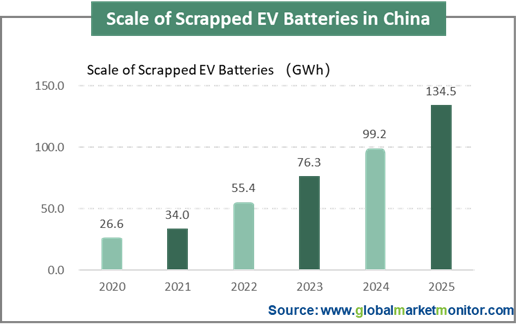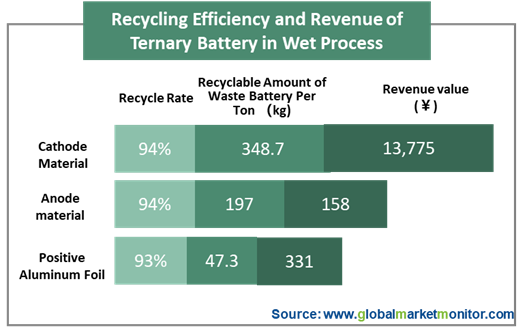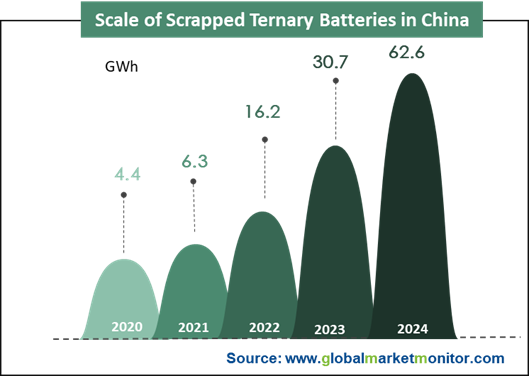The Potential of Dismantling and Recycling Is Huge While Echelon Utilization of EV Batteries Is Controversial
The Amount of Scrapped EV Batteries Will Reach the First Peak
In 2018, the global lithium-ion battery recycling market reached 111,783 tons, and it is expected to reach 641,595 tons in 2025, during which the compound annual growth rate will be approximately 26.57%.
At present, EV batteries mainly include lithium iron phosphate batteries and ternary batteries. According to the calculation of the 5-year lithium iron phosphate battery scrap period and the ternary lithium battery scrap period of 6 years, the EV battery will enter a large-scale scrap period starting in 2019, which is expected that in 2020, the retired EV batteries in China will accumulate about 26.6GWh.

At present, developed countries in Europe, America, and Japan have built a complete recycling network in portable batteries and start-up batteries (lead batteries). However, there is no mature experience in the recycling of new energy vehicle power batteries not only in China but also in the developed countries.
Get Your Custom Report Immediately:
https://www.globalmarketmonitor.com/request.php?type=3&rid=413868
China is the largest market for new energy vehicles in the world, and the government has actively formulated relevant policy standards to guide the orderly development of the power battery recycling industry.
At present, EV battery recycling industry of the new energy vehicle can be more clearly divided into three links of the recycling system, cascade utilization, and reuse.
Studies have shown that the capacity of lithium iron phosphate batteries is less than that of ternary batteries. When the number of ternary battery cycles is around 2500, the battery capacity is reduced to 80%. While the cycle life of lithium iron phosphate batteries is more than 3500 times, the capacity is slowly declining as the number of cycles increases. The material composition of the lithium iron phosphate battery does not contain precious metals, whose resource value is low. Therefore, the lithium iron phosphate battery has a high step utilization value, and the ternary battery is suitable to disintegrate and reuse because it is rich in a variety of valuable metals.
Echelon Utilization Is Mainly Used for Low-Speed Electric Vehicles and Electric Energy Storage
The national standard issued by the Ministry of Industry and Information Technology stipulates that the mass of an electric bicycle equipped with a complete battery should be less than or equal to 55kg, promoting the use of lighter-weight lithium-ion batteries for electric vehicles as the weight of the lead-acid battery is about 17kg. Therefore, echelon utilization is expected to become the preferred battery for electric bicycles under the new national standard.
Get Your Custom Report Immediately:
https://www.globalmarketmonitor.com/request.php?type=3&rid=538992
In terms of echelon utilization in energy storage, China Southern Power Grid has tried several demonstration pilots, which completed and put into operation the first national demonstration project of the decommissioned battery echelon utilization in energy storage in Guangzhou in March 2018, which used lead-acid decommissioned batteries. Since then, Shenzhen, Lijiang, and other places have successively initiated research or pilot projects on echelon utilization in energy storage for retired lithium batteries. The total capacity of the Shenzhen project which uses both lithium iron phosphate and ternary lithium batteries of China Southern Power Grid is 2.15MW/7.27MWh.
However, there are many controversies in the society about the cascade use of batteries. Because how to judge the actual remaining capacity and health status of a battery, how to estimate the number of remaining cycles and the discharge amount of the full life cycle, will directly affect the pricing of this battery in the market. At the current technical and economic level, the answer cannot be obtained in a reasonable and low-cost way, nor can a consensus be reached among the car manufacturers, users, and recycling agencies, and energy storage power plants, which leads to high circulation costs and reduced circulation efficiency. The problem of the echelon utilization of the battery is yet to be further resolved.
Recycling in Wet Process: Higher Recovery Rate for Valuable Materials
The recovery process of the EV battery can be roughly divided into three steps, consisting of pretreatment, material recovery, and screening preparation, which generally includes three major methods of physical recycling, chemical recycling and biological recycling.
More chemical methods are used due to the high energy consumption, low recovery rate, and certain waste pollution of the physical method, and the biological method is still in its infancy, which is not suitable for being widely used at this stage but has great development potential. Although the cost of chemical methods is higher, it can be ignored as a high cost in return for high yield and a high degree of automation.
The ternary battery has a high content of high-value metals, which mainly adopts the wet recovery process to realize a high recovery efficiency. According to relevant calculations, the average profit per ton of ternary batteries recovered by the wet recycling process is more than 17,000 yuan, and the processing cost is about 15,000 yuan. Therefore, the wet process can recover about 3,000 yuan per ton of ternary batteries.


The Domestic Recycling System of EV Battery Is Still Inadequate
At present, the construction of EV battery recycling system in China is not perfect, which will spend a long time to formation a recycling network. The companies should focus on the research and development of EV battery recycling-related technologies to enhance core competitiveness with technology.
That China has started early in the field of new energy vehicles is expected to achieve the advantage of overtaking in the automobile industry. In the entire chain of new energy vehicle development, the important link of EV battery recycling cannot be ignored. In the future, the construction and improvement of EV battery recycling system in china will also require the participation of multiple market players to work together and fulfill their responsibilities.
LEARN MORE:
New Energy Vehicle
https://www.globalmarketmonitor.com/reports/413868-new-energy-vehicle-market-report.html
New Energy Vehicle Lithium-ion Battery
Custom Reporting


